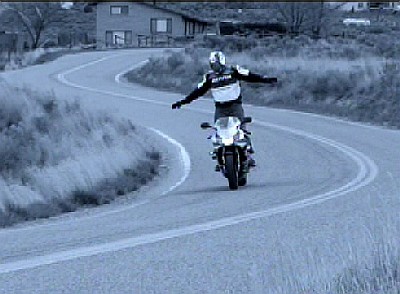Originally Posted by
Rob MacLennan 
The first thing that you have to realize, about motorcycles, is that they are inherently unstable. If you don't hold them up, they fall down. Everything after that is gravy.
I don't want to confuse the OP but that comment ONLY applies to motorcycles that are stopped or going very slow.
Like a top they ARE inherently stable and do not want to "fall over" when moving...the trick is to master the physics of that.
A properly designed motorcycle is extremely stable when in motion.
[TABLE="width: 1024"]
[TR]
[TD]Wheel Stability [/TD]
[/TR]
[TR]
[TD="align: center"]
[/TD]
[/TR]
[/TABLE]
[TABLE="width: 1024"]
[TR]
[TD]
- A spinning wheel, by virtue of its rotational inertia, is stable. The greater the speed of the spinning wheel the greater the stability. Rotational stability is diminished as the wheel speed approaches zero - which is why it is much easier to balance a bicycle or a motorcycle when the wheels are spinning rapidly.
- A motorcycle spinning wheel is stable even if it is not in contact with the ground, e.g., wheelies are much easier to control if the front wheel is spinning rapidly when it's in the air (see videos below).
- A force or torque is required to change the direction, lean or speed of a spinning wheel. A spinning wheel may move forward or backward, side to side, or up and down freely - but a torque is required to change the orientation of the wheel or its rotational speed.
- Spinning wheels (and crankshafts, sprockets and gears) possess a quantity known as angular momentum (l = mvr) The greater the mass, the radius or the speed of the spinning wheel the greater the angular momentum (and the greater the rotational inertia). The greater the angular momentum, the greater the amount of torque required to initiate a change in direction or lean angle in a spinning wheel.
[/TD]
[TD]
 Video courtesy of The History Channel, "The Works"
Video courtesy of The History Channel, "The Works" [/TD]
[/TR]
[/TABLE]
[TABLE="width: 1024"]
[TR]
[TD]
- When a torque is applied to a rotating wheel along an axis perpendicular to the rotational axis of the spinning wheel (as in steering a motorcycle or a bicycle) it results in another rotation of the wheel (precession) about an axis perpendicular to both the original rotation and the applied torque. This results in leaning.
- Gyroscopic effects are influenced by chassis design. Performance motorcycles are engineered to straddle the divide between performance and stability.
[/TD]
[/TR]
[/TABLE]
this will get you a ticket but it is a good demonstration
Slow speed handling especially two up and in traffic takes practice - that is where stability is tricky.
Rolling along on good roads with even a modicum of engineering on curves is effortless.
Spiriting riding with tighter curves, decreasing radius curves ( nasty ) and off camber takes caution and experience to master.
Dirt and gravel are entirely different skills and can and in my view should be a part of an experienced riders skill set.
Road bikes generally are fine ridden carefully on dirt roads and riders should tackle a few from time to time to know how their bike reacts - in traffic on a construction zone is not the time to find out.
Gravel on corners can be a concern if riding hard and even at times when casual riding - just don't panic and over control - again - practice in a parking lot - see what it feels like.
Saddle time not distance is critical. Most of us are always rusty after the winter lay off. You can get 8-9 months good riding in this part of Ontario.
ALL activities carry risks including cooking and stepping into a bath or shower. Some common sense and caution and willingness to improve skills can dramatically reduce risks.
I've 43 years riding, still all intact... a few falls in winter under very adverse conditions and lots of falls on the trials bikes - that all is useful for road skills.
The nice thing with the big scoots is it removes entirely one aspect and that is shifting and clutching.
I'll never go back and most riders who experience a good CVT or DCT would not either as it allows you to entirely concentrate on handing and braking and the conditions around you.
The future is moving that way....not a bad way to start in an urban setting.


















